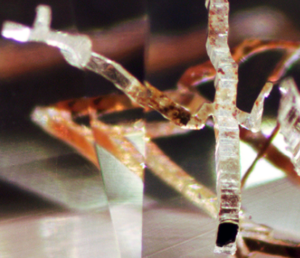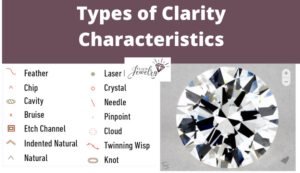
There’s no doubt you want to minimize imperfections when you’re buying a diamond.
One of the first features you’ll notice when you examine a diamond is whether it’s free of any blemishes or contains blemishes such as dark spots or hazy clouds.
A diamond’s clarity is determined by the size, color, and position of those imperfections. These flaws are called clarity characteristics, or inclusions, and marked on its grading report.
My bottom line recommendation is that you should be aware of the size and types of inclusions present in a diamond, but you priority should be whether it’s eye-clean, which means inclusions aren’t visible without magnification.
Start with SI1 clarity, and work your way up the scale until you find the right fit. For my wife’s engagement ring, I landed at VS1.
In this article, I’ll discuss each type of clarity characteristic and how they impact the quality of your diamond.
1. Bearding
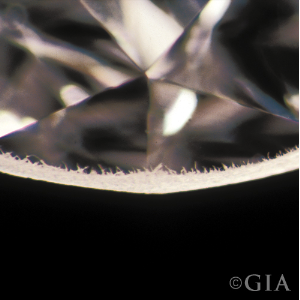
Bearding is most frequently the result of damage from equipment that harvests diamonds. This is unlike many other types of inclusions, which occur naturally.
When a diamond is cut, hair-like lines can be cut into the diamond as well. They extend from the girdle out to the surface of the stone.
This is often unavoidable, but there are varying degrees of bearding. A heavily bearded diamond may have a fuzzy or cloudy appearance that resembles the accumulation of many tiny scratches. This can impact the clarity and sparkle of the diamond.
2. Needle
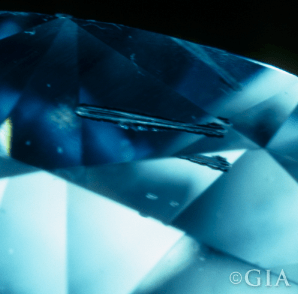
Needles aren’t considered an impactful inclusion in regard to a diamond’s quality. They’re long, needle-like lines that appear within the inner surface of a diamond.
Needles are usually white or transparent, which makes them difficult to see. Even under 10x magnification, they often aren’t visible because the lines are so thin.
The only significant problem posed by needle inclusions is if they appear in a cluster. This affects the clarity of the diamond by interrupting light flow and giving the diamond less shine.
3. Indented Natural
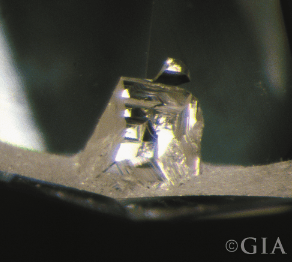
An indented natural inclusion becomes apparent during the process of preparing to sell the diamond.
Diamonds are polished to remove rough outer textures and increase the amount of light that can enter the stone. During the polishing stage, an indented natural is uncovered because it appears as a dip below the smooth, polished surface of the rough layer underneath.
It’s part of the rough diamond texture that isn’t touched during the polishing process, and it’s typically seen on or near the girdle. Further polishing can sometimes get rid of this inclusion.
4. Feather
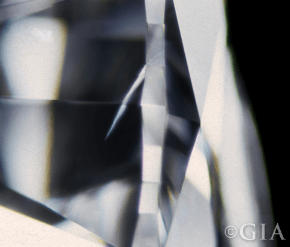
A feather inclusion is a small crack or fracture within the inner structure of a diamond. Feathers can consist of one broad line but typically have several small cracks that branch out. This feature is what gives it a feather-like appearance.
Feathers are often transparent but cause durability issues with the diamond that affect overall longevity. A feather can worsen over time, and if multiple intersect with each other, it can cause the diamond to break or chip.
5. Cavity
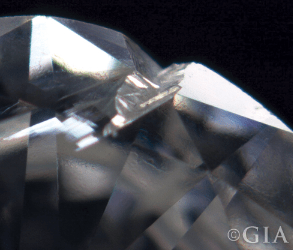
A cavity is a type of diamond inclusion that’s a large hole or crater in the diamond’s surface.
They’re the result of polishing that has dislodged a weak portion of the stone or breached the surface of an already existing inclusion of another type.
A problem with cavities is they can trap dirt and oils on the surface of the diamond, creating black spots that are visible to the naked eye.
Cavities can sometimes be removed during the polishing process. The downside of removing cavities is it can result in the diamond weighing less, which means it will sell for a lower price.
6. Chip
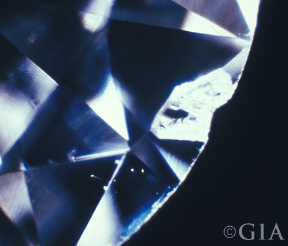
Chips are small, shallow openings on a diamond’s surface that usually appear near the girdle, culet, or facet intersections.
The most common cause for chips is human error such as dropping the diamond or hitting it against a hard surface.
A chip is similar to a cavity inclusion because they both appear on the surface of the diamond. However, a chip is usually a more minor inclusion and has a lower likelihood of significantly decreasing the stone’s value.
One way to prevent a chip inclusion is to use a bezel setting instead of a prong setting because it protects the outer edges of the diamond.
7. Cloud

A cloud inclusion encompasses a wider range of flaws that fall under the category of pinpoints or crystals found too closely together.
These points create a hazy, cloud-like effect that reduces the ability of the diamond to transmit light. Without adequate clarity of light transmission, the diamond will appear dull.
Cloud inclusions are generally not large enough to warrant a significant drop in overall clarity. They’re normally confined to small areas only seen under magnification.
8. Twinning Wisps
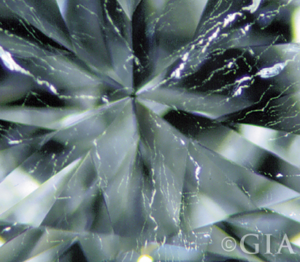
Twinning wisps is a broader term used to encapsulate other inclusion types such as pinpointing, clouding, and crystals, as they pertain to the growth of the diamond itself.
A diamond may stop growing altogether if conditions are unfavorable during the growth process, such as if multiple types of inclusions start forming.
Twinning wisps form when that growth continues in another direction compared to the original. The restarting of its growth process can occur thousands of years after formation halted.
9. Crystal
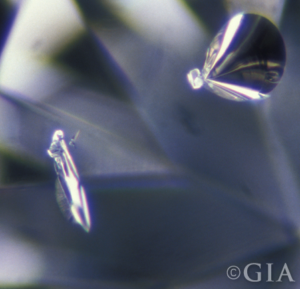
This type of inclusion refers to a crystal forming within the diamond itself.
A diamond with tiny ruby or emerald crystals inside may sound more valuable, but it can leave a diamond undesirable.
Crystals have the tendency to appear as opaque or colorless but can also form in color.
Splotches of red, blue, and green within your diamond are distracting and take away from the sparkle of the larger stone.
Size is also an important component when determining how much of the diamond’s value is lost because of crystals.
10. Graining
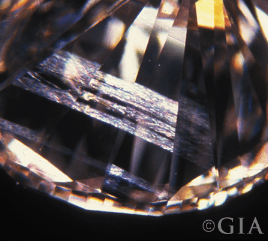
Graining is a natural inclusion that occurs during the formation of the diamond. It’s the result of irregular crystal growth and can appear on the inner part of the stone, as well as the surface.
Graining on the surface means the diamond could still be graded internally flawless, but it would not be graded flawless.
Internal graining gives diamonds a milky and cloudy appearance that impedes the transmission of light for sparkle. It can also leave faint lines or streaks that look like creases, depending on the severity.
11. Knot
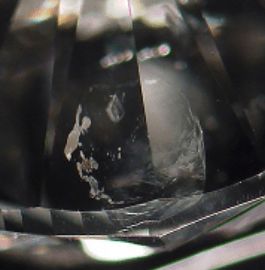
A knot inclusion is a raised bump of crystal on the surface of the diamond. It’s revealed through polishing and is usually white or transparent.
It’s one of the most easily hidden types of diamond inclusions.
Further polishing diminishes the protrusion of the bump, but this can also decrease the value of the diamond because it lowers its overall carat weight.
Another easy way to hide this inclusion is by choosing a setting that will cover it.
12. Pinpoints
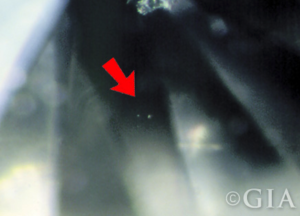
Pinpoint inclusions are small crystals that form on the interior surface of a diamond. They’re either black or white and look like a tiny dot — often only viewable under 10x magnification.
Black pinpoints lower the value of a diamond more because of their increased visibility. A group of pinpoints has the same effect, regardless of color, and this phenomenon is also referred to as clouding or twinning wisps.
13. Bruise
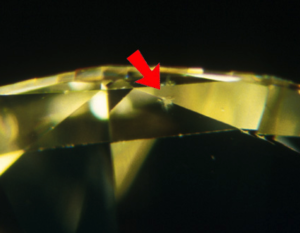
A bruise inclusion is a result of hard force or impact on the diamond.
They’re man-made during the polishing process and result from cutters increasing the speed or pressure of the polishing wheel on the diamond’s surface.
The bruise forms just below the surface of the diamond and can sometimes be removed through further polishing — as long as the bruise isn’t made worse during the process.
14. Etch Channel
Etch channels are hollow tunnels that begin on the surface of a diamond and pierce its body. It’s appearance is similar to a laser drilled hole but can also form as parallel lines.
They’re likely formed when high temperatures penetrate the stone’s crystalline structure.
Dirt can get trapped inside the channels, diminishing its overall quality. That’s why it’s recommended to avoid diamonds with etch channels on the pavilion side.
Some jewelers attempt to remove this type of inclusion, but it does result in reducing the weight of the diamond.

Jacob Clarke
Jacob Clarke is the founder of TeachJewelry.com.
He earned an Applied Jewelry Professional Diploma from the Gemological Institute of America (GIA) and now brings you essential information about diamonds, settings, and more.
Jacob has consulted with leading jewelry brands, and his work has been cited in Clean Origin, Diamond Nexus and industry publications.
He's also a member of the International Gem Society.
He enjoys discussing jewelry with readers, so contact him with any questions at jacob.clarke@teachjewelry.com.

